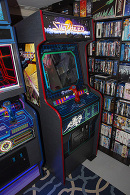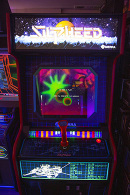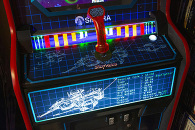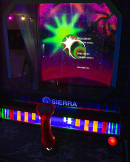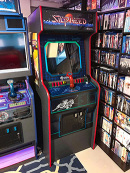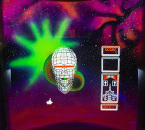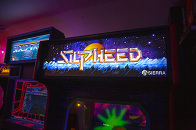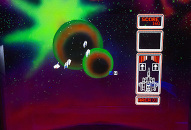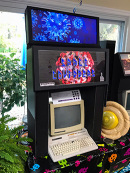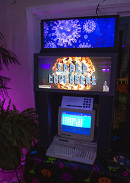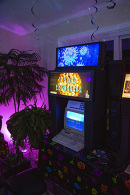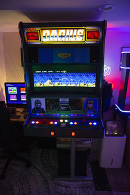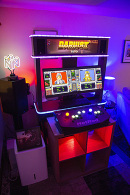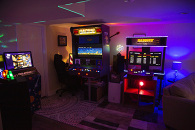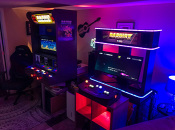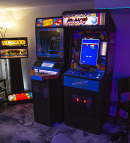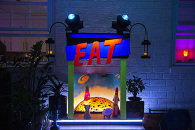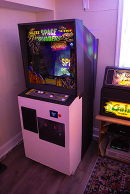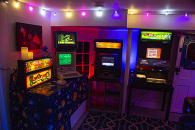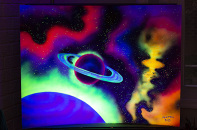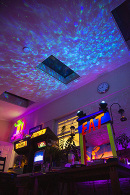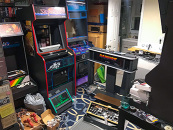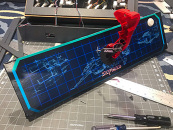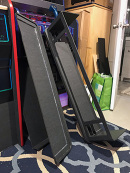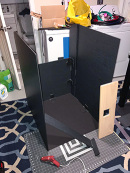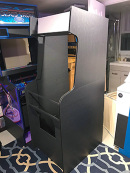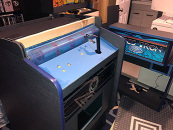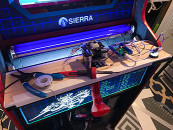Silpheed: The Arcade Game (Sort Of!)
Re-Imagining a Classic in a New Format and Behind the Scenes

Have you ever wondered what Silpheed might have looked like had there been an arcade version of it? Most likely the answer is no; Still, I thought why not find out? It seemed to me like a natural candidate; the gameplay is arcade-like, the controls are simple enough to be picked up quickly, unless you're good a game only takes a few minutes, and the game even has a demo resembling an arcade game's “attract mode”; not at all unlike many arcade shooters! So, I embarked on a project to not only imagine what such a beast might look like but to actually build a complete, actual size, playable cabinet. Here are some photos and an overview of the final results...
The Silpheed Arcade Cabinet
Without further delay, let's get to a few photos to check it out; Click on the thumbnails to view the full-size image.
You can also view more photos in the gallery Silpheed: The Arcade Game at PixelatedImages.
Now a little more about the cabinet; OK, I'm not entirely sure what people may actually want to know, but here's some more details and the answers to a few questions I suspect may come up.
The cabinet is approximately 70.5 inches (179.07 cm) tall, 27 inches (68.58 cm) wide, and 43 inches (109.22 cm) deep. The depth is from the deepest point; the cabinet was actually intended to be only about 32 inches (81.28 cm) deep, but I miscalculated the monitor and mirror angle. The result of that was the game appeared as if it was behind the backdrop instead of in front of it! Attempting to take apart and reposition everything was proving too difficult and time consuming, so I had to eventually resolve that by simply making the cabinet deeper. It doesn't show well in photos, but the 3D effect that's created looks quite impressive in real life, although the cabinet is larger and takes up more space than originally intended. The cabinet is, for the most part, built out of foam core board. There are a few exceptions; the control panel is made of wood, custom cut plexi-glass is used for the marquee, display bezel, black light cover, and a two-way mirror, and of course there are the various computer and control parts. The coin door is plastic, and actually opens/closes and locks; it is a 3D printed replica I found on Etsy.
What Version of the Game Is Used?
The cabinet is running version 3.2 for DOS. This is the version originally packaged with the IBM PS/1 Audio Card and is the only one to feature digitised sound effects; music is provided by the Roland MT-32 driver. The emulator running the game is an SVN version of DOSBox (Specifically, DOSBox-X). This version of DOSBox is used since it allows emulation of both the PS/1 and MT-32 which is missing in some DOSBox versions; The result provides what I consider the best possible audio experience for the game. The EGA graphics version is used which is the best looking mode for the DOS version of the game and is also very similar to the PC-88 original.
What Hardware and Software is Running the Game?
The computer running DOSBox is a refurbished Lenovo ThinkCentre desktop with an Intel Core i5, 8 GB ram, and Windows 10. It's not the most state of the art gaming PC around, but it was quite cheap and provides more than enough power for simply running Silpheed in DOSBox. The effect of overlaying the game graphics over a hand-painted backdrop is achieved by using a two-way mirror; the painting is behind the mirror, and the monitor is in front facing up. Known as Pepper's Ghost Illusion, the technique was used by several early arcade games to provide color and detail in an era when hardware was limited (games including Space Invaders, Asteroids Deluxe, Discs of TRON, and more did this). The catch is, because the game is reflected off of a mirror the display needs to be reversed. Emulators such as MAME have this ability built in; after all, it's oriented towards arcade games with many needing this feature! DOS games, on the other hand, typically wouldn't and so the feature is missing in DOSBox. To get around this, I used UltraMon for reversing the image. One thing to note that the UltraMon documentation doesn't make particularly clear is that you will physically need a second monitor for the effect to work; so hidden in the bottom of the cabinet is another monitor while the one you can see is the secondary monitor displaying a mirror image of the primary one. There may be a better solution than this, but I was running out of time and it worked well enough! The joystick is from Suzo Happ; the red casing is actually a recreation of the one used by Satan's Hollow created by Groovy Game Gear, and luckily it's the same size and shape so I simply swapped out the black case with the red one. An LED-Wiz by Groovy Game Gear controls the joystick and buttons. To control the LED lights in the buttons, LEDBlinky was used.
How Was the Artwork Done?
Primarily in Photoshop. As I have several copies of the game, I was able to scan elements from the box and instruction manual at a high resolution for editing and eventually printing. Several materials were used for printing, including backlit film (more commonly known as translite), poster paper, and adhesive film. The backdrop is an exception; this was created with an airbrush. The painting is on matte board which is curved slightly giving it a nice appearance of some depth. The paints are UV paints so they glow brightly under a black light which is exactly what is used to illuminate the final painting.
Is the Cabinet Really Built With Foam Core Board?
Yes, it really is! Foam core board provided a solution for me to a few issues. A big one is that I have little experience working with wood; While wood would have been more solid and durable, I lacked the tools to effectively use it. Tools can be acquired, of course, but that just led to the next issue of where could I use them? I don't have a garage or workshop, so anywhere inside would have made dust a large problem. Working outside, while possible, would have presented it's own challenge depending on how well the weather cooperates. In contrast, glue and foam core could be done in the basement without sending dust everwhere plus the tools were quiet in contrast to woodworking so I could even have conversations while building without being interrupted by the noise of a saw or similar. So, foam core it was or, realistically, the project would never have happened, not at this time at least. And just how many pieces of foam core does it take to build a Silpheed? The answer is aproximately 334! I kept a handy sheet of paper nearby and added a mark to it each time I cut a piece of foam core; by just looking at the cabinet from the outside that number may sound rather high. It can be a bit deceiving, though, as there are a lot of small pieces for support that are hidden in the interior. How strong is the resulting cabinet? It's suprisingly solid! I'm not sure I'd go put this in a local arcade, it wouldn't be able to take the abuse a real machine can, but it is stronger than one might suspect. Part of the reason is a large part of the cabinet is made from Elmer's Mighty Core brand foam board. This type is much sturdier than regular foam board and yet is easy to cut clean edges on; perfect for the project! Unfortunately, it seems this has been discontinued; due to some corporate acquisitions, this division of Elmer's is no more and Mighty Core is no longer sold unless someone happens to have some unsold inventory (in fact, I suspect I'm responsible for purchasing the entire remaining inventory from Blick Art Materials). There may be some replacements or even the same material under a new name available, but I'm not sure yet.
Could a Real Cabinet Have Been Modified?
Why not use a real arcade cabinet and simply modify it into Silpheed? That is a possibility I considered. At the time, I wasn't having much luck finding a cabinet I liked that was in decent shape yet either incomplete or not working and all of that at an affordable price (including shipping if not local). I didn't want to ruin a working game, and the incomplete/broken ones were in poor condition (for the same reason I avoided building out of wood, I didn't want to buy a cabinet where the condition was too rough and required extensive restoration). So while this should be possible and work very well, I didn't really have enough time to pursue the idea further. Additionally, the foam core cabinets have the advantage of being much lighter than a wood one; I'm not sure exactly how much it weighs, but attempting to use a bathroom scale (not the best way to do this!) gives me an estimate of somewhere around 150 - 160 lbs where a real cabinet is typically over 200 lbs.
Do you have any videos?
Yes! Here's some clips of the game in action...sorry for the shaky quality, setting things up for some higher quality video is on the neverending to-do list, so hopefully this will do for now.
Other Cabinets and Decorations
Silpheed wasn't the only cabinet built; I had done several a while ago as well as others were built at the same time as Silpheed (probably due to Covid supply chain delays, I had to set it aside from time to time while waiting for parts to ship). Some of the other cabinets are also full size while a few of them are “mini-cabinets” — the mini-cabinets are incomplete in some way, usually they're not full height and sit on a desk or table or are just a stand with a marquee. One notable change is for later cabinets I switched from the LED-Wiz to the I-PAC Ultimate I/O by Ultimarc for the control board. Both boards work incredibly well, but I find the I-PAC quicker to install as you can buy prewired buttons, joysticks, and other components that just plug in. And finally, also using foam core, numerous decorations were created for an authentic (well, sort of...) arcade mood. Here's a few examples.
Space Covidders
Remember the game Space Commanders? It was a rather well done Space Invaders style game for the IBM PC released way back in 1983. And now, there's an impressive update for today's Covid world! VileR of int10h.org put together an impressive version of them game that updates the alien invaders with viruses! Find a great writeup, view videos, and download the game from his blog entry 'Space Covidders' Goes to the Arcade?. I didn't have a full size cabinet for this, instead I ran the game on a Tandy 1000 HX and created a custom marquee; So here's a few pictures of the Space Covidders mini-cabinet:
The marquee lights change colors too; here's a quick video showing the effect.
Darius and Darius II
I've long been partial to side-scrolling shooters, and the Darius Series is a favorite! So I finally got around to creating a pair of cabinets for Darius and Darius II. These are not full size; if you've never seen the actual cabinets, especially the Japanese versions, they are huge so an accurate replica wasn't practical! These are still extremely fun to play, and at 36.5 inches (92.71 cm) wide, the Darius cabinet is about the same width as the real thing even if it's only the top half. For Darius II you'll notice what looks like a HanaHo HotRod joystick; it is! I had to modify it, though; it's an older PS/2 connector model and didn't work well with a PS/2 to USB adapter. Plus, there are more buttons than needed for Darius II, so to avoid confusion I wanted to have only the buttons that were needed to light up (as an added bonus the joysticks also light up). I took the thing apart and used an I-PAC by Ultimarc to power the new light up joysticks and buttons; This worked incredibly well; no one had any problem figuring out which controls to use plus it saved some time by not having to build a complete control panel! So, here's Darius and Darius II:
Miscellaneous Cabinets and Decorations
Finally, here's a few random shots of some other cabinets and various party decorations. Besides the various cabinets (both full size and mini versions) running emulators, I have also had real hardware setup (which always presents challenges when something that's been in storage for a bit decides to break last minute!). There's not enough time or room to go through each game in detail, but also setup was Discs of TRON, Donkey Kong Jr., Arkanoid, Space Invaders Deluxe (converted from my previous Space Invaders cabinet), Jungle Hunt (using my Qix cabinet), Lode Runner on an Apple IIe, H.E.R.O. on an Atari 2600, Super Amok on a Commodore VIC-20, and more. Here's a few photos of the setup...
Behind the Scenes
How did all of this look during construction? Here's what the work-in-progress mess looks like at various stages. I actually had several cabinets and decorations in-progress simultaneously, mostly because I had some delays acquiring some parts which held up progress (Covid related supply chain issues I'm guessing?). With a party deadline approaching quickly, I didn't have much time to waste, so what became my construction room turned into all-out chaos for a while. For a further glimpse into the building process, also check out some more photos in the Behind the Scenes gallery over at PixelatedImages.
More Photos
I have more photos posted at PixelatedImages; For a quick reference, here are the links to the galleries mentioned above:
- Silpheed: The Arcade Game
Photos of the completed Silpheed cabinet. - Other Cabinets and Decorations
Photos of Space Covidders, Darius, and all of the other cabinets and decorations. - Behind the Scenes
Photos of all of the above during various stages of construction.
And that is all! I hope you enjoyed seeing my unusual Silpheed creation and this behind the scenes tour of PixelatedArcade. Until next time, stay safe, stay healthy, and take care!
